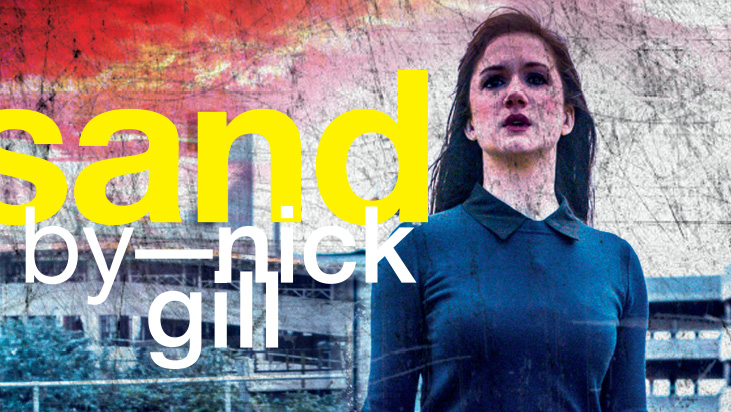
It’s always hard when you have to do a monologue on stage, but a 40 minute intense one with only one week practice is pretty much impossible. Yet that is what Sara Lloyd Gregory did. Even though she had her script on stage she didn’t falter one bit. Taking on Sand by Nick Gill, a monologue that took on the themes of grief, war and nuclear weapons. Sara’s intensity kept gradually building until the very end when she just blew us away. Her vocal training and breath control was impeccable even when the pace was phenomenally quick.
Kate Wasserberg, director of this production lead this performance to a success, the timed pauses and the changes in emotions and attitudes were completely on point. One thing that also has to be applauded was the use of sound by Sam Jones and lighting by Katy Morison, both aspects made the performance mesmerising to watch and in some parts it even felt like it was in a different dimension.
One of the main aspects I love coming to watch the Other Room’s seasonal performances is that they always pick challenging pieces yet they always bring in such professional actors that completely deliver.
Tag Archives: Kate Wasserberg
Review Play/Silence The Other Room by Kaitlin Wray
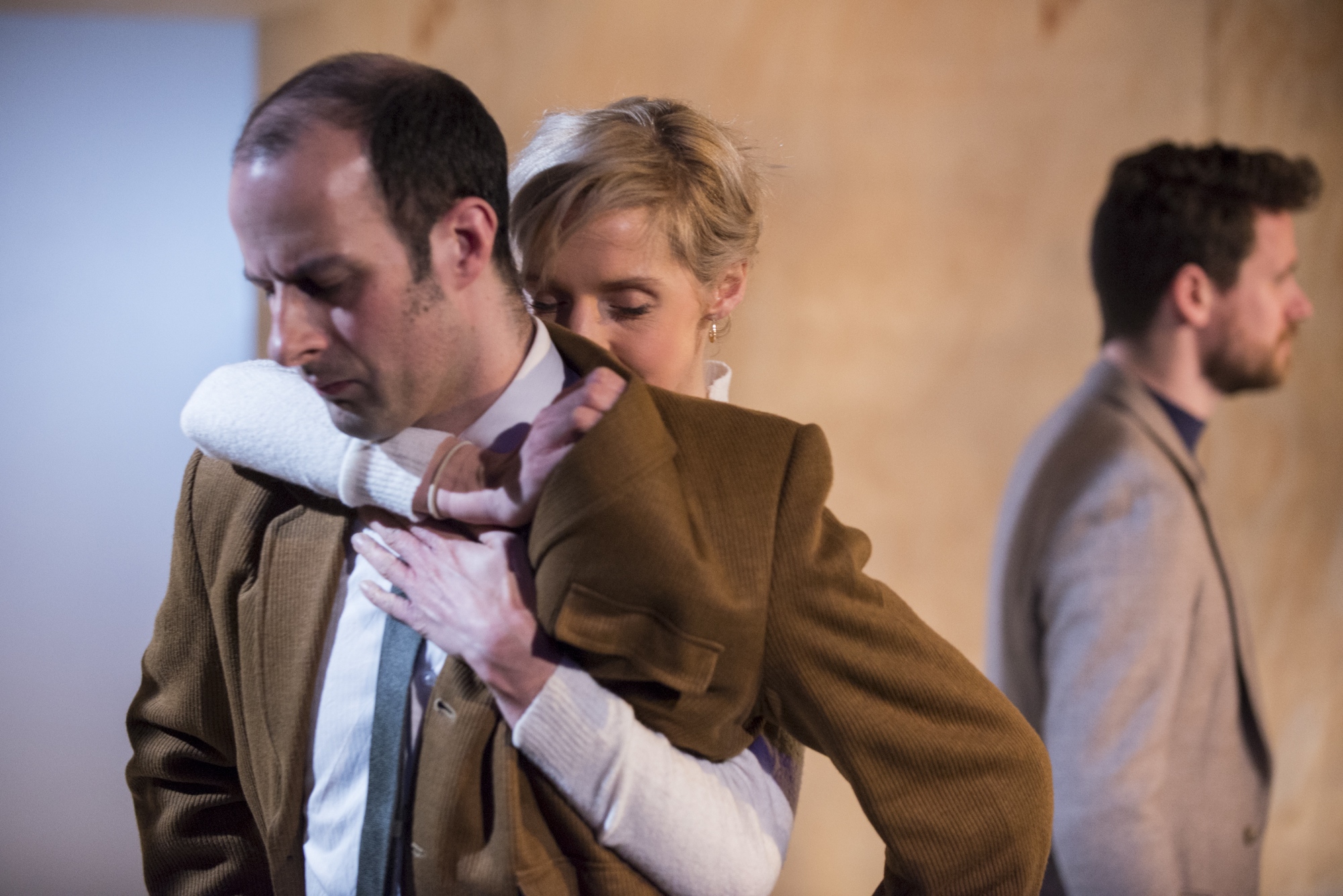
The Other Room Theatre kick of 2016 with their new season ‘Insomnia,’ bringing us a double bill of both Beckett and Pinter’s work. These 20th century playwrights are considered to be two of the most influential dramatists of all time.
The plays ‘Play’ by Beckett and ‘Silence’ by Pinter, both draw on themes around betrayal and lust. Both Kate Wasserberg, (director of ‘Play’ and Artistic Director of the Other Room) and Titas Halder, (director of ‘Silence’) made sure these plays were not only performed with great distinction but also showed great technical accomplishment.
Stepping into the first performance of the Other Room theatre there was soundscape in the background (composed and sound designed by Dyfan Jones) creating the mood that was hardly noticed at first but grew louder and louder until everyone was completely engaged and then it just cut out. A deathly silence where the audience was left in the pitch black, all senses removed, waiting in suspense. This was the first moment that completely drew me in to the performance, this moment never left me until I was ushered out of my seat. I was in complete awe at what I had just seen.
Floating heads on stage, muttering things one couldn’t comprehend, the imagery in this was beautiful. Then controlled by a single spotlight it shone onto the character speaking at the time with everything else surrounded in blackness. This technically was beautiful as we were transfixed on what was being shown. It felt like you were at a tennis match where you kept moving your head to the next performance not wanting to blink in case you missed the next moment.
The performers were incredible, their focused stare and fast paced speaking with hardly pausing was a treat to see. It was evident that they had complete dedication to this performance as their pronunciation was spot on even though the pace was remarkably difficult. The trio of performers even though they were speaking in quite a monotonous way showed great characterisation and we could fully get a sense of each personality.
After only knowing Matthew Bulgo through his great work as a playwright on ‘Last Christmas’ for Dirty Protest, his acting ability corresponded to the success of his play. Acting alongside him was Victoria John who showed comedy within this play and who’s laugh has to be up there with the greatest of evil laughs. Then Peta Cornish who captivated us with the use of her eyes and her elegant speaking voice.
This was a performance that frazzled my mind yet I would want to see it again and again just to get another glimpse into those lives.
The second performance, Pinter’s ‘Silence’ was technically less demanding but nonetheless just as beautiful, the simplistic set worked really well and it felt like the actors were in another dimension. What I noticed most of all was their use of spatial awareness, when one person moved to a different spot, the others would change their position so it always looked aesthetically pleasing to the eye. This was well thought through and blocked. The performers acting was equally accomplished with Matthew Bulgo playing Rumsey, showing us a more desperate side than the comical side we saw earlier, Peta Cornish playing Ellen uses her eyes as an emotive tool which was something I haven’t seen in a long time in a performance, truly remarkable. Then, Neal McWilliams playing Bates. Neal played a character who had a boyish charm that really put extra depth into this performance and made it stand out so much more. Each performer showed us what it felt like to be in desperation of love and hope, to have such strong feelings and the want to connect with one another.
This double bill was a great way to step out from the outer world into something much deeper. This is a performance that makes you feel something you definitely didn’t feel before entering the room. As an actor myself these plays are something every actor dreams to play, the way they are technically demanding for the voice and how you have to be completely disciplined with your whole body making sure you know every tiny movement you make will have great impact on the performance. I thoroughly enjoyed the night and cant wait to watch the Other Rooms next performance of ‘Sand’ by Nick Gill.
Photographic credit Pallasca Photography
Review Play/Silence The Other Room by Kiera Sikora
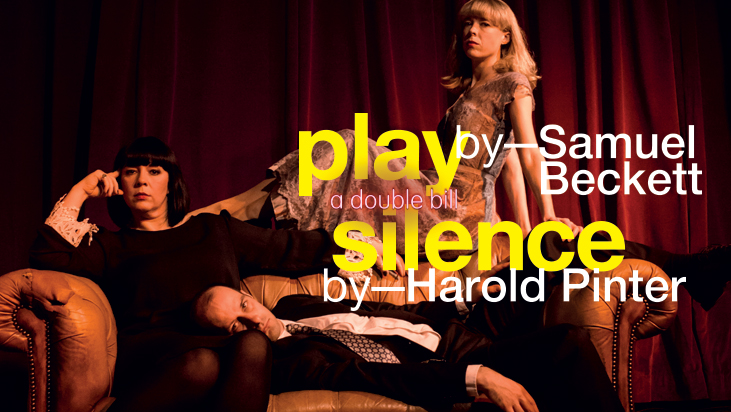
It’s not often you get to say that you’ve seen both a Beckett and a Pinter play in one night, in an hour in fact. But The Other Room at Porter’s, yet again, delivers for it’s audiences a night of theatre that affects you and lets you indulge in it’s rarity.
‘Play’ begins, with whispers and hiccups from the faces in the glittering urns, designed wonderfully by (Amy Jane Cook). With the yellowish glow of rapid spotlights we hear the intricate thoughts of the man, the mistress and the wife. The hiccups, the pauses the whispers and the humour all a collection of brutally honest thoughts, each monologue justified by the other person’s words. On the left hand side we have W2, the wife of the man, played by Victoria John and next to her we have the Man in the middle (quite literally) played by Matthew Bulgo and to his right, W1, Peta Cornish, playing the mistress.
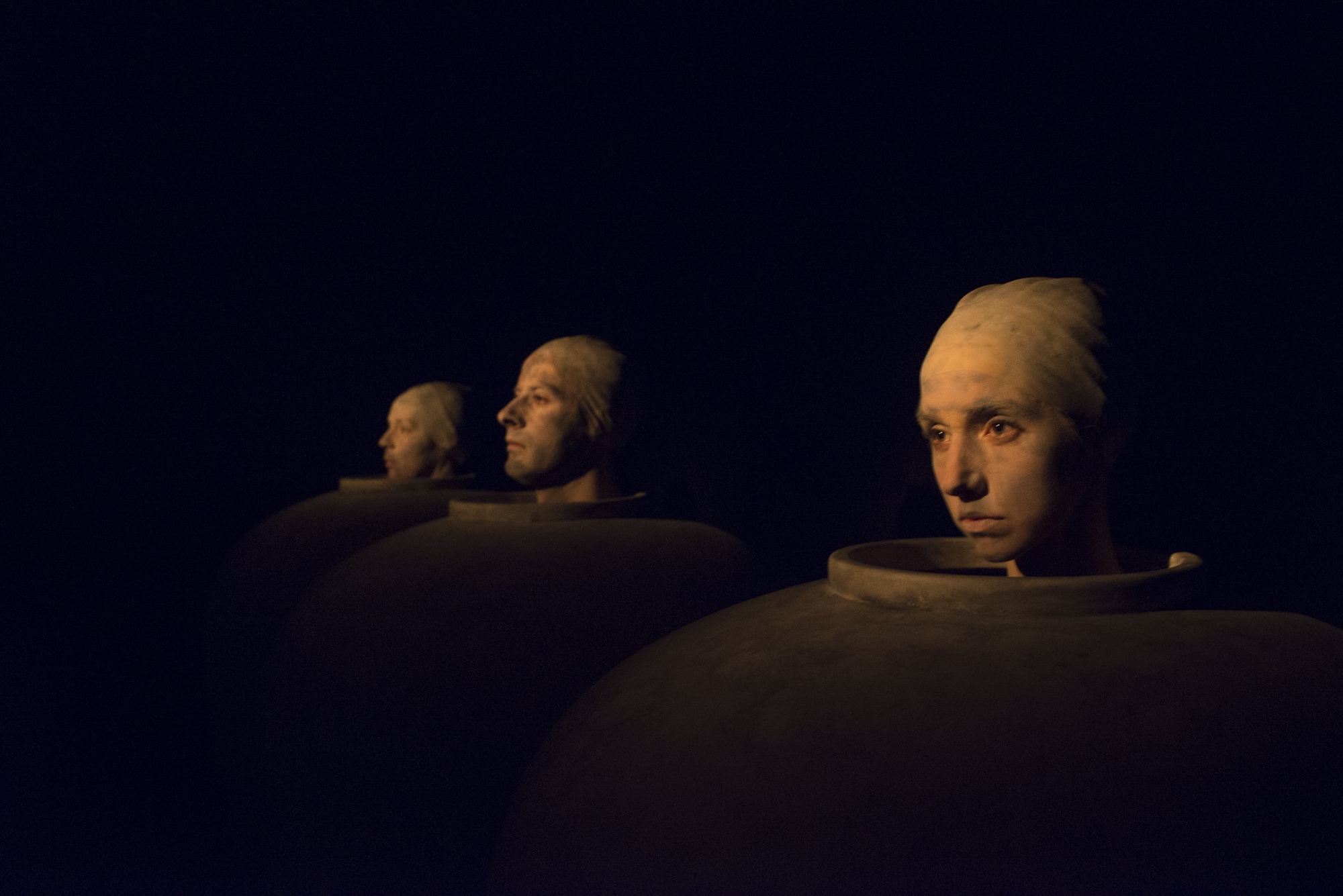
We race through the interior monologues, each contribution giving more than just verbal circumstance. We see what one could believe to be martial unhappiness mixed with a sense of neglect, regret and direct bitterness cleverly composed using just a few base notes and the odd pause, disguised as a ‘pardon’. The repetition in the piece doesn’t annoy, it’s evokes a different sense, a sense of memory. You feel comfortable enough to react but the lack of an entrance or exit reminds you that this is not a place to get comfortable in. To be alive in a funeral urn and only allowed to speak when the moonlight-like spotlight chooses you, in a place where you can’t imagine daylight- who knew it could be so comic?
After a short interval, one I wish hadn’t had to have taken place, we move on to ‘Silence’. A play that marked a change for Pinter, and certainly marks a change in this double bill. The actors are present on a well lit stage, looking lost in thought in a simple set of wooden side walls and a blank dim square at the back of the stage, representing a window.
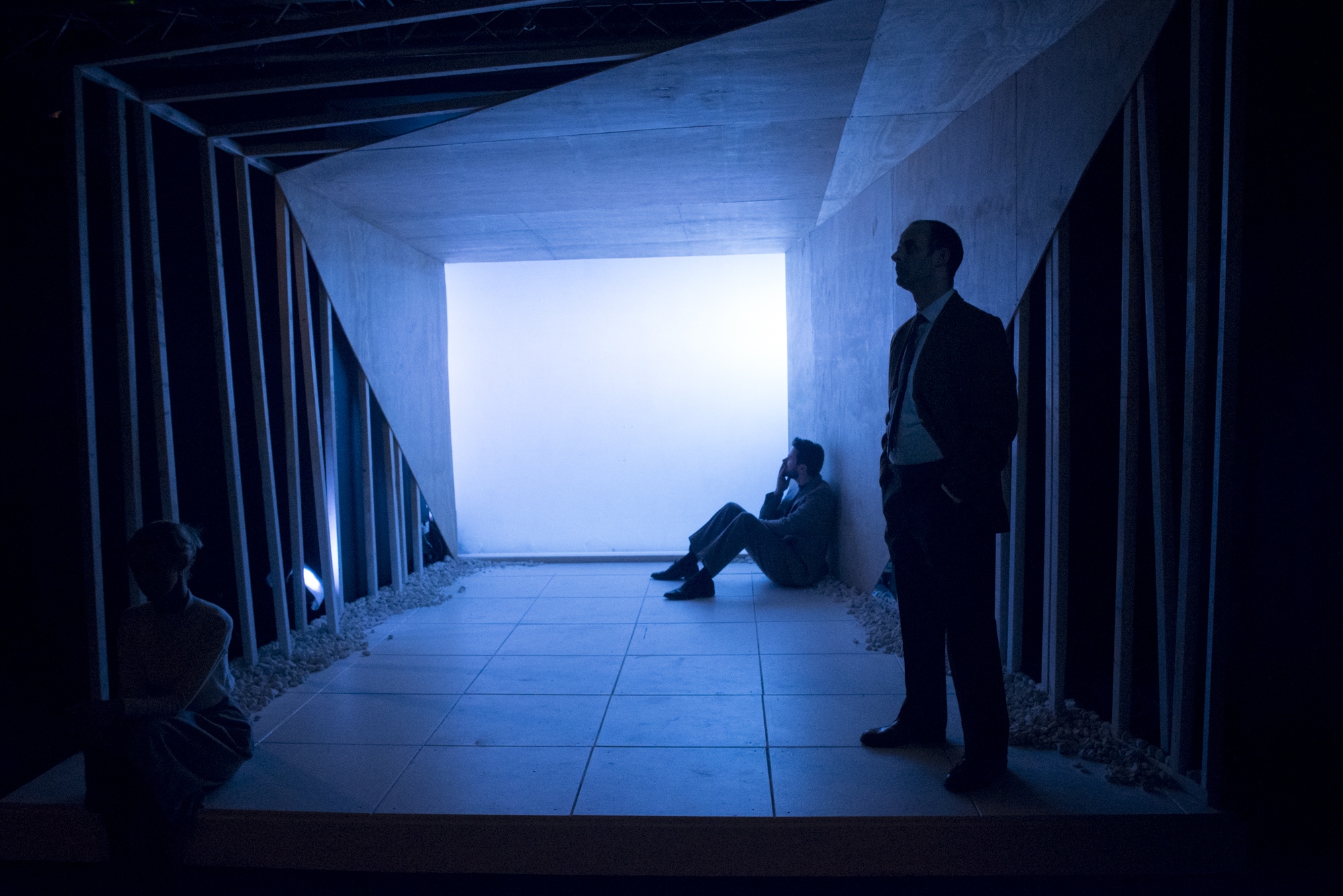
Like ‘Play’, we are met by three characters, each sharing the space and look of nostalgia, and then Rumsey speaks. The interior monologue begins, this time casually, with a hopeless honesty exploring ‘the fleeting nature of love’ and the isolating recalling from what I gather to be different periods of time. Rumsey, played beautifully by Matthew Bulgo, poetically recalls his thoughts and ends as he begins, lonely and living from his past. Bulgo’s delivery of Rumsey’s first line is wonderfully ideal. We also meet The gentle Ellen played by Peta Cornish, who is this time, the lady in the middle. The middle of what is something that’s not completely clear from the text but as the monologues unfold we see the pasts of both these characters merge. We also meet Bates played by Neal McWilliams, a man who doesn’t share Rumsey’s soft tones but does share his interest in Ellen. He is the man Ellen had to choose after being rejected by Rumsey and ultimately, she loses loses him too, this time by choice, and they all have to live from within their memories and wonder what could’ve been, had life played out their ideal.
Both plays speak volumes and allow us as the audience to make sense of them, if we so wish. The directors Kate Wasserberg (Play) and Titas Halder (Silence), along with the entire cast and crew deserve multiple applause for attacking two brilliant plays and creating another fantastic night of insightful theatre.
Play/Silence runs at The Other Room at Porter’s until February 5th. It’s an unmissable double bill of the exact type of theatre we need. Go see, you won’t regret it!
Photographic credit Pallasca Photography
[vimeo 152270795 w=500 h=281]
<p><a href=”https://vimeo.com/152270795″>Play/Silence – a Beckett/Pinter double bill</a> from <a href=”https://vimeo.com/tudleyjames”>TudorFilms</a> on <a href=”https://vimeo.com”>Vimeo</a>.</p>
Life in Close Up: The Other Room’s First Season Overview by Rebecca Hobbs

Life in Close Up: The Other Room’s First Season Overview
Now that The Other Room’s opening season has reached its close, Kate Wasserberg and her team can breath their first sigh of relief after a hugely successful critical and public response to three very unusual plays. Spatially, with just forty-four seats, it was an apt move to shape the first season around the intimate experience that The Other Room offers as the performance sits on top of you wherever you are situated. As a final round up to reflect on the ‘Life in Close Up’ season’s antics and audience appraisals, I had the opportunity to catch up with artistic director Kate Wasserberg and Alun Saunders, the writer of ‘A Good Clean Heart’ to address those niggling questions and observations that struck me during these performances.
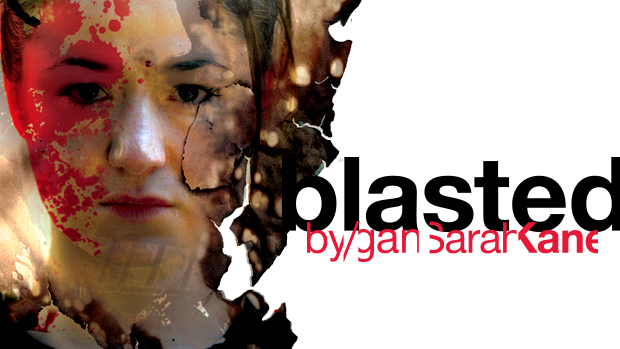
Sarah Kane’s Blasted (1995)
It was bold choice by Kate and the The Other Room team to open the season and the theatre itself with a play that is engulfed in controversial and challenging criticism. The late 90’s reviews had originally brandished Sarah Kane’s Blasted as a sordid and immature piece of writing that for all intensive purposes was written to shock. Despite many of these accusations being revised, launching the ‘Life in Close Up’ season with Blasted instantly stimulated debate and got people talking about what the The Other Room in Cardiff was doing. This was my first piece as a young critic and I had no idea what to expect. After briefly flitting over a Wikipedia synopsis, I initially struggled to grasp the script’s bizarre intentions. However, after seeing it performed as a play rather than reading out a list of violent gimmicks, it became clear that these online summaries are hugely damaging to the play’s reputation; the impact lies within the performance. Despite its controversial standpoint, The Other Room’s production was given a 4* rating by The Guardian and overall it excelled in its reviews from critics who were somewhat shaken but left in awe.
Blasted- A Close up with Kate Wasserberg (Artistic Director)
Q: Recently, with Sherman’s ‘Iphigenia in Splott’ and Chapter’s more ambitious programme, Cardiff theatre seems to have dropped the conservative barrier but a script of this intensity has very rarely been performed on Welsh soil. This was out of Cardiff’s theatrical comfort zone. You clearly had confidence in the script and the fantastic cast. Were you concerned about the play’s notoriety and about challenging the relatively safe expectations of theatre that Cardiff sits comfortably with or did you anticipate that this would fuel its success? Despite the fact that I cannot pretend to have necessarily enjoyed watching Blasted, it was an unforgettable experience and one that has successfully conjured a huge critical response.
Kate: I have always thought of Blasted as a really honest, heartfelt play. Of course I was aware that it is shocking in places and yes that was a conscious decision, to offer up something new. But the main motivation was not so much a response to the arts scene but as a way to attempt to articulate the world as I was experiencing it at the time, not as wholly dark but certainly with cruelty and pain and callousness out there, on the news. The critical response was really varied, and the first few reviews that came out, they really disliked the show and that was quite a raw experience – I can’t remember the last time I have felt so exposed, the cast were giving these incredibly courageous performances and we hadn’t had long to rehearse it really so I felt very protective. But that’s part of doing this play, and approaching it the way we did – head on with no deliberate style. It’s not for everyone and you have to accept that. Of course then more reviews came out and some people did really like it and that was lovely and the audience started to feedback to us and we grew in confidence, but all responses are perfectly valid and that rawness is part of the experience, I think.
Q: Initially, I struggled to distinguish what exactly had bothered me about the play which was odd because the shocking violent junctures are overtly clear and it surprised me that they were not my primary concern. It was the moments of sympathy embedded in the horror, Kate’s uncontrollable laughter and the desperate cry for help read through Ian’s eye contact during the rape. It was the fact that there is never an entire loss of humanity which as an audience member is what you crave in order to dismiss what you have witnessed. Were you specifically conscious about how these moments were going to be directed?
Kate: I think I was, yes. Our starting point as a company was to be as real as possible – to ask, but what if this really was happening? It sounds a bit trite to say it now but in a play that is known for being shocking, it was important for us that the people were complex and human and real. Christian, Louise and Simon were all totally fearless about allowing themselves to go to some very difficult places emotionally and that did take a toll on them at times, but I think they all felt like we were engaged in something quite special and it was worth the vulnerability they felt.
Q: I am sure, particularly with this play, you witnessed a whole spectrum of reactions as people came out of The Other Room. Is there a specific response that stands out to you?
Kate: It was a bit odd in previews – perfectly content, happy people came in and shaken, crying people came out and I genuinely thought, my god, what are we engaged in here? Why do that to people? But of course to be moved is wonderful, even when it’s dreadful. I remember a group early on who really laughed at the jokes, right through to the end, they were wonderful. And an actor friend of mine who literally couldn’t speak, she had to call me the next day. But that’s the play – that’s Sarah Kane and her brilliance. We just tried to do her justice really.
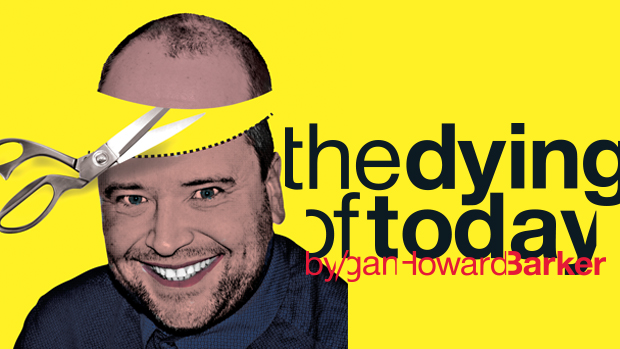
Howard Barker’s The Dying of Today (2008)
After the hype of the first production, expectations were high for the second play in the series, Howard Barker’s The Dying of Today. Inspired by Thucydides’ account of the destruction of the Sicilian expedition during the Peloponnesian War, the play is constructed from that anxiety induced moment of inevitability, considering the worst case scenario in order to deduce how we process the phenomenon ‘bad news’. This was an equally challenging script for entirely different reasons. Barker’s play is stripped of distractions; its plot can be summarised by one line. To keep an audience attentive when the play is entirely based around a conversation with two people in such a mundane environment is a challenge for any director and two man cast.
The Dying of Today- A Close Up with Kate
Q:When I came to see this play, I distinctly remember that I still had half a drink left after the production came to a close. I was immediately drawn into the performance. It almost had a hypnotic effect on me and I think that had a lot to do with the narrative’s rhythmic pace and the fluidity of Leander Deeny and Christian Patterson’s interactions. How did you initially approach this script, was maintaining the momentum a high priority?
Kate: Definitely. We slowed right down in rehearsal to get the detail in but we always had our eye on pace and the confidence with which the ideas develop. It’s acrobatics in some ways, part of the joy is watching them leap from one idea to the next without stopping. Dneister (Leander Deeny) talks for seven minutes without stopping at the beginning of the play and that in itself; to talk ceaselessly and hold the attention of those listening, is a daring feat, especially when the ideas are so complex. Then the barber (Christian Patterson) joins and seems at first to be much simpler and slower but he very quickly builds his own pace and the whole show feels almost like a running race, exploding into physical action with the destruction of the shop.
Q: When the material that is being performed in front of you is as intense as Blasted, the space suddenly becomes very theatrically claustrophobic but for The Dying of Today, the chess board floor manipulates the size of the performance area and it feels deceptively bigger. Has it been a challenge to make the best of such a small space? In this case, what inspired the retro fifties salon? I loved the concept of the audience being the reflection of what we were watching as we sat waiting in anticipation for the news ourselves.
Kate: I definitely wanted the space to feel radically different for each show in the season and for it to be as exciting to walk into The Dying of Today as it was for Blasted, when the audience were seeing the theatre for the first time since the conversion. The 1950’s feel was about tying to distil the essence of a barber’s – a sort of reference that everyone would recognise. We tried to references various time periods throughout to stop the play feeling ‘set’ in a time or place but we also really wanted it to feel like a real shop, that was very important, that these enormous ideas unfolded in this very prosaic environment. But it had a bit of romance too, which was partly about searching for a bit of softness after the rawness of Blasted.
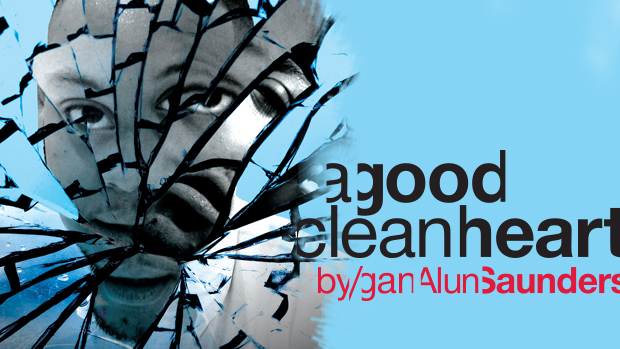
Alun Saunders’ A Good Clean Heart (2015)
The final play in the season was a newly commissioned bilingual work by Alun Saunders, a Welsh writer from Neath who trained as an actor at the RWCMD. A Good Clean Heart addresses a number of challenging questions about our cultural and personal identity but this is a truly unique piece of theatre for its ambitious and playful engagement with language. The play follows the story of two brothers raised in different cultures and familial environments; Hefin, adopted in Wales, well educated and a first-language Welsh speaker and Jay his older brother now living in London with his biological mother who they were originally taken away from. When Hefin is finally told on his eighteenth birthday of a sibling who has been reaching out to him, in a moment of spontaneity he initiates the long awaited meet where the pair struggle to come to terms with the years they have lost. Along with the discovery of his English roots, Hefin is introduced to his brother at a rather inconvenient time with the police waiting for an opportunity to bring Jay back in. The reunited family home is thrown into chaos where mother and sons are forced to make decisions that will impact the rest of their lives.
A Good Clean Heart- A Close Up with Alun Saunders
Q: Firstly, llongyfarchiadau on the incredible success that you have had with ‘A Good Clean Heart’. You must be thrilled with its critical reception?
Alun: Diolch! Thrilled is definitely one of the words… It’s a pretty overwhelming thing pouring your heart into a play without actually knowing how people are going to react. Did I say ‘overwhelming’? I mean terrifying. I imagine even seasoned Writers find it scary putting their work out there for public consumption as they’re under a different sort of pressure – the pressure to ‘keep up the good work’. For me, writing my first full-length play, I wanted to see whether what I had to say, and how I choose to say it, had a place in that public arena. The public and critical reception has absolutely spurred me on to knuckle down and write more. I’m really grateful.
Q: When you were addressing the notion of identity, it came across as a very fluid concept. I loved the intricate ways that this was incorporated into the script with James Ifan and Dorian Simpson jumping into the role of their mother and her boyfriend, drawing out that play on identity crisis. Whilst a national identity is a necessary central focus of the script, were you conscious to avoid restricting the definition of identity?
Alun: Abso-blinkin’-lutely. Having done a good bit of research into how people felt (and how strongly they felt) about their own ‘national identity’, I got such a varied response – some people aren’t bothered at all by it, where some people feel that it absolutely defines who they are. The important thing for me is that people are unique; stereotypes exist, but always with an element of contradiction (I’ve actually been called “a boy full of contradictions” myself). Whilst we constantly try to ‘order’ and categorise other people in order to help ourselves sort the ‘friendly /attractive/ positive’ from the ‘unfriendly/unattractive/negative’, nobody can decide our identity except ourselves. It was important that the characters of Hefin and Jay had a strong identity – even if that changed during the play – and that the audience were allowed to come to their own conclusions.
Q: Finally, in addition to the demanding technical work needed to create that bilingual accessibility, there was also a lot of visual play on language to the point that the words were literally bouncing of the walls. Was the animation of language and the bringing language to life something you enjoyed physically constructing?
Alun: From quite early on in the development of A Good Clean Heart, Kate Wasserberg and Mared Swain the plays director and I had discussions about the technical possibilities of this play. It’s been such a huge collaboration of ideas and skills to bring what was eventually seen to life, and I just feel honoured that so many people’s hard work created this success. For my part, I needed to create characters which the actors (and subsequently, the audience) could believe in, and a story and dialogue to channel that. I was always conscious, whilst writing, of the technical possibilities, so I was interested to see how we could bring a letter, an email and an online chat to life on stage, but the focus was always on where the story was going. Especially by Draft 14…
Kate: Huge praise is due to Zak Hein, who designed the animation, including the subtitling. He worked with Mared to create an incredibly bold visual language for the play that made the bilingualism a joy and also made the show very youthful. I think it worked brilliantly.
Alun: As a Playwright, writing my first full-length play under Kate and Mared’s mentoring has been invaluable. I’ve been pushed to the limits (and beyond) of what I thought I could manage, but seeing the end result has been worth every last blistered typing finger, every tear and 4am coffee. Had I given up four or five drafts ago then my life may, theoretically, have been ‘easier’, but the play we’d have ended up with would have been much weaker for it. I’m really grateful to those whip-cracking slave-drivers for believing in me, and for pushing me to get where we all wanted – only then could we justify the whole team’s hard work. Now to decide where we take it next…
A Final Word on the Season’s success…
Q: The Other Room has clearly hit Cardiff by storm, you must be very happy with the overall response to the first season?
Kate: Of course, we are and incredibly touched and grateful that so many people have supported the project – by coming to the shows, spreading the word and bringing people along. We are so proud to be part of this fantastic city and hope to continue to be worthy of our brilliant audience.
Q: What can we expect next, are there big plans in the pipeline?
Kate: We are putting the finishing touches on our next season and I’m deep into programming 2016. Some very exciting plans and a new way of working – we’ll keep you posted!
The Other Room will be hosting its first Young Arts Festival from 18-20th June where young talents will be showcased through a series of short plays written and performed by all those participating in the week’s festivities. For more information visit: http://www.otherroomtheatre.com/en/whats-on/current-productions/
A huge thank you to Kate and Alun for taking time out of their busy schedules for Young Critics.
